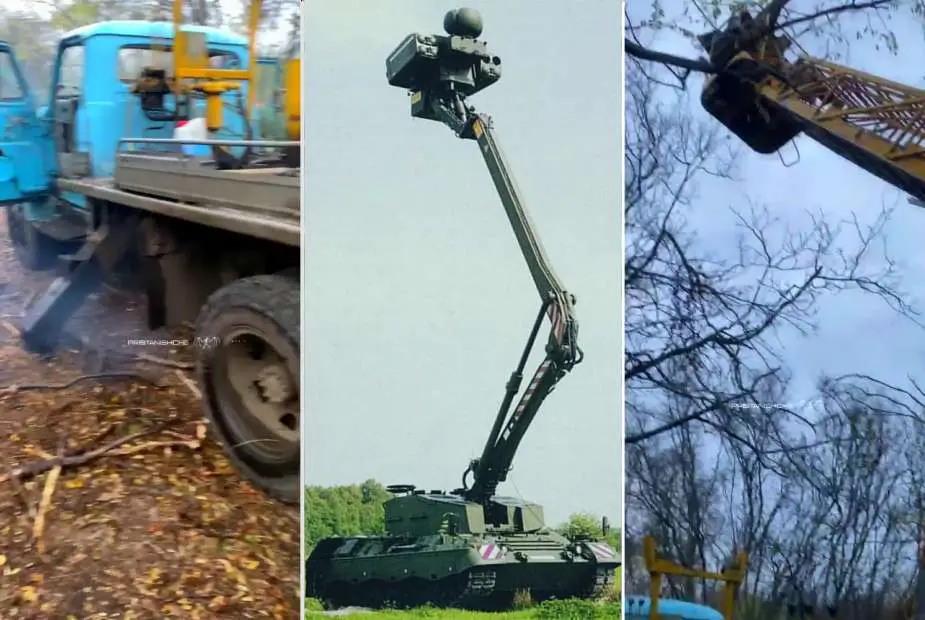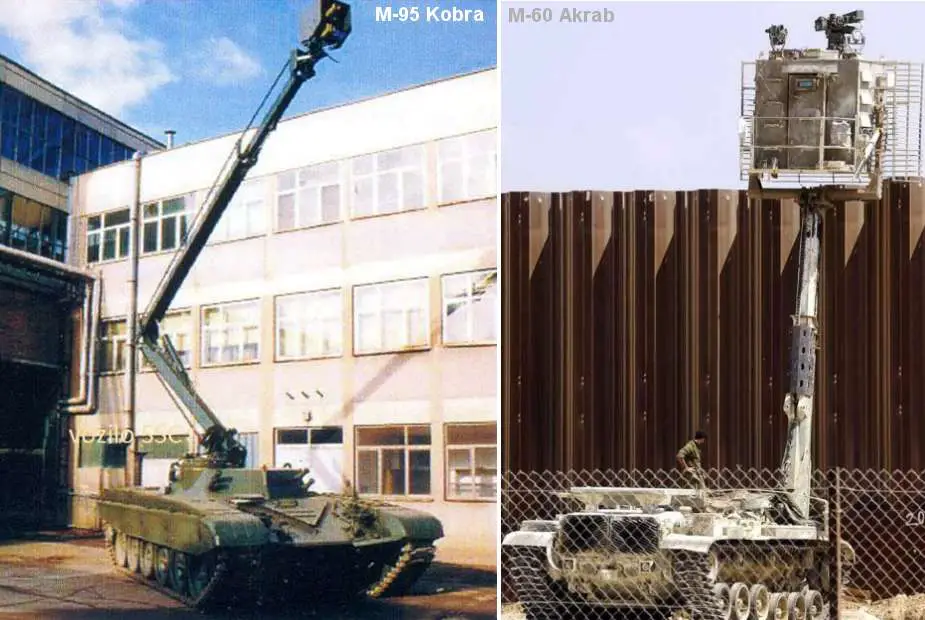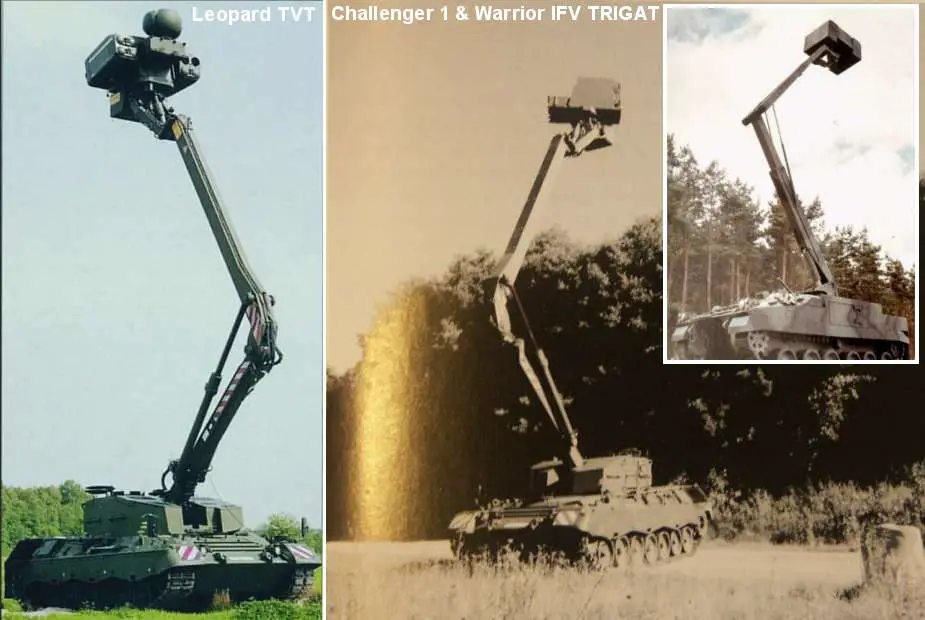- Army
- Conflicts in the world
- Israel - Iran conflict 2025
- Pakistan - India Conflict 2025
- Russia Ukraine War 2022
- Libya conflict day by day
- HAMAS - Israel War 2023
- Operation Serval in Mali French Army
- Sangaris operation Central African Republic
- Sangaris opération militaire République Centreafrique
- Ukraine - Russia conflict
- Syria conflict news
- Defence & Security Industry Technology
- Armies in the world
- Analysis Defense and Security Industry
- Conflicts in the world
- Navy
- Air
Russian soldiers revive outdated Cold War-era Giraffe vehicle in Ukraine
As reported by Andrei_bt on November 18, 2023, Russian soldiers adopted an unconventional strategy known as the 'Giraffe' concept to provide anti-tank guided missile (ATGM) operators with an elevated vantage point. The shared video depicted an ATGM system, likely a Kornet system, mounted on the telescoping platform of a civilian 4x4 truck. The presumed location was a wooded area within Russian-occupied Ukraine.
Follow Army Recognition on Google News at this link

Russian soldiers employed the Giraffe vehicle tactic in Ukraine, similar to the approach used by the Germans with the TVT tank destroyer during the Cold War. (Picture source: Twitter/Andrei_bt and Odd Tank Poster)
The Giraffe concept's core principle involves using telescopic weapon platforms to enhance visibility and overcome obstacles, primarily for anti-tank missiles. This configuration aims to offer ATGM operators an unobstructed line of sight over wooded terrain, potentially extending several miles. Traditional ATGMs typically rely on laser, radio, or direct commands and necessitate an obstacle-free path to the target. The elevation of the firing platform is a crucial factor influencing the effectiveness of these weapons, as demonstrated by the taller turret of the US Army's M2 Bradley infantry fighting vehicle compared to its predecessor. This taller turret provided a tactical advantage in Iraq for TOW missiles.
However, the Russian attempt to replicate Giraffe vehicles, like its historical predecessors, includes potential challenges, such as stability during missile guidance, vulnerability during deployment, and concerns about cost-effectiveness, leading to the abandonment of similar projects in the past.
The historical context of the Giraffe concept can be traced back to 1937, with the British patent for the Praying Mantis, with two prototypes constructed in 1943 combining a Universal Carrier's tracked hull with a telescoping turret. Designed to shoot over walls and other obstacles, the vehicle, when moving, frequently gave the crew members motion sickness and was extremely difficult to control, leading to its abandonment in 1944.
Continued efforts during the Cold War, undertaken by various countries, often in response to the Soviet armored threat, led to these vehicles being commonly referred to as 'Giraffe.' This nickname originated from their frequent operation at heights exceeding 6 meters above the ground, surpassing the typical height of a giraffe, which is 5.5 meters. The vehicles in question included the Croatian M-95 Kobra, based on an M-84A tank, the British Challenger 1 tank and Warrior IFV armed with TRIGAT missiles, the Polish Dragon, the Swiss Leopard 1 ADATS, and Israel's M60 Akrab (Scorpion), potentially built on an older M48 chassis and equipped with sensors, a remote weapon station (RWS), and anti-RPG grilles. The United Kingdom also used a mini-Giraffe vehicle, known as the FV1620 Humber Hornet.

Examples of tank-based Giraffe vehicles include the Croatian M-95 Kobra based on an M-84A and the Israeli M60 Akrab, potentially built on an M48 chassis. (Picture source: Reddit/Tank Porn and Twitter/Caesar)
German engineers explored the integration of anti-tank guided missiles (ATGMs) on liftable modules, leading to the development of the Trilateral Versuchsträger (TVT) tank destroyer in the 1970s. This vehicle, based on a Leopard 1 tank chassis, featured remotely-fired anti-tank missiles mounted on a 60-foot telescoping mast. In 1981, France, Great Britain, and Germany entered into an agreement to jointly develop the PARS 3 LR (Anti-Tank Missile System 3-Long Range) missile. This missile was designed for deployment in both helicopters and vehicles, with the aim of replacing the HOT guided missile by the 1990s.
By 1991, the three nations opted to adopt the German TVT concept for the Panther tank destroyer to showcase the system's functionality from a ground-based platform. The TVT, weighing 41.5 tons in combat, featured a platform that could be raised to a height of 12.5 meters in less than 30 seconds using an articulated arm mast.
The combat area module housed two control stations (commander and gunner), enabling battlefield observation via monitors. Target reconnaissance, selection, and missile instruction occurred from these stations. The platform incorporated an OSIRIS sight with a stabilized viewing mirror and launchers for a total of eight PARS missiles.
Subsequent firing tests in 1996 proved both successful and encountered challenges. The overarching PARS 3 LR program faced difficulties, leading to Great Britain's withdrawal in 1993 and France's indefinitely postponing missile procurement in 2005. After a 30-year development period, Germany established a procurement plan to acquire 680 missiles between 2009 and 2014, intending to equip the Bundeswehr's 80 planned Tiger support helicopters.
Over time, the Giraffe concept has expanded beyond its initial anti-tank focus, encompassing various military applications. This diversification includes reconnaissance vehicles equipped with cameras, thermal imagers, autocannons for self-defense, or laser systems designed for countering helicopters, with some of these variations persisting to the present day.
The gradual disappearance of the Soviet tank threat, the emergence of helicopters armed with anti-tank missiles, budget constraints, and inherent challenges associated with anti-tank Giraffe-like systems collectively contributed to a declining interest in and funding for these ATGM platforms among military decision-makers.
The decisive factor in the decline of Giraffe-like platforms was the advancement of modern anti-tank guided missiles (ATGMs), exemplified by systems like the Javelin. These missiles demonstrated the capability to autonomously navigate obstacles by adjusting the guidance system's height, thereby rendering the need for Giraffe-like platforms obsolete. However, despite this trend, some Russian soldiers decided to revive and employ such platforms in Ukraine.

Frequently constructed atop tanks like the Leopard 1 or Challenger 1, Giraffe vehicles were occasionally adapted to Infantry Fighting Vehicles (IFVs), as seen with the British Warrior. (Picture sources: Twitter/Odd Tank Poster and Reddit/ Tank Porn)


























